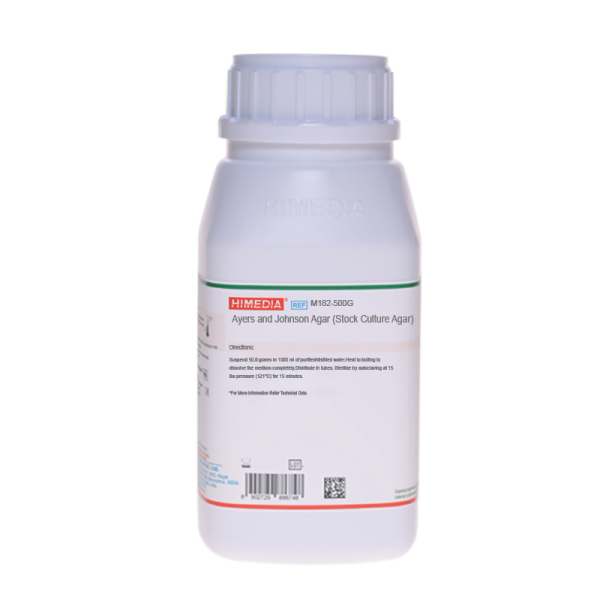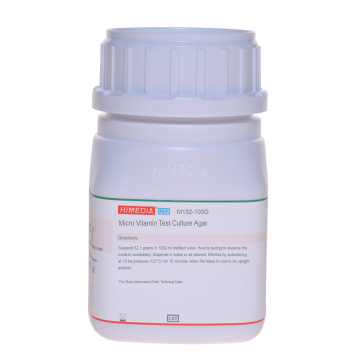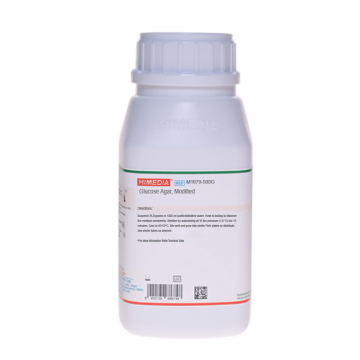 Your enquiry has been submitted
Your enquiry has been submitted
Ayers & Johnson Agar (Stock Culture Agar)
Intended Use
Recommended for maintenance of cultures of Streptococci and other microorganisms.
Composition**
| Ingredients | g / L |
|---|---|
| HM infusion B from 500g # | 10.000 |
| Proteose peptone | 10.000 |
| Gelatin | 10.000 |
| Dextrose (Glucose) | 0.500 |
| M-protein, purified ## | 5.000 |
| Disodium hydrogen phosphate | 4.000 |
| Sodium citrate | 3.000 |
| Agar | 7.500 |
Final pH ( at 25°C) 7.5±0.2
**Formula adjusted, standardized to suit performance parameters
# Equivalent to Beef heart, infusion from ## Equivalent to Casein, purified
Directions
Suspend 50.0 grams in 1000 ml of purified/distilled water. Heat to boiling to dissolve the medium completely. Distribute in tubes. Sterilize by autoclaving at 15 lbs pressure (121°C) for 15 minutes.
Principle And Interpretation
Maintenance medium are essentially designed to maintain the viability of cultures over an extended period of time. Stock Culture Agar was originally formulated by Ayers and Johnson (2). They observed that in addition to supporting luxuriant growth, the medium also helped in maintaining the viability of Streptococci and various other organisms over a long period of time. They also observed that Streptococci maintained their viability for as long as four months when incubated in this medium at room temperature (25°C). Stock Culture Agar serves its main purpose (i.e. maintaining viability) chiefly due to its semisolid nature, a well-buffered environment and the presence of casein and dextrose, the latter, which serves as a source of energy.
Many fastidious organisms like Mycobacterium species, S. pneumoniae, show good growth on this medium. It can be made especially suitable for maintenance of Streptococci by the additions of L- Aspargine (1g/l) (1).
HM infusion B, proteose peptone, gelatin and M-protein, purified serve as sources of nitrogen, vitamins and amino acids. Dextrose is a carbon and energy source. Disodium phosphate serves as a buffering agent while sodium citrate acts as a preservative.
Type of specimen
Pure isolate
Specimen Collection and Handling
After use, contaminated materials must be sterilized by autoclaving before discarding.
Warning and Precautions
Read the label before opening the container. Wear protective gloves/protective clothing/eye protection/ face protection. Follow good microbiological lab practices while handling specimens and culture. Standard precautions as per established guidelines should be followed while handling specimens. Safety guidelines may be referred in individual safety data sheets.
Limitations
- Further biochemical and serological tests must be carried out for complete identification.
Performance and Evaluation
Performance of the medium is expected when used as per the direction on the label within the expiry period when stored at recommended temperature.
Quality Control
Appearance Yellow to beige homogeneous coarse powder
Gelling Semisolid, comparable with 0.75% Agar gel and 1.0% Gelatin gel.
Colour and Clarity of prepared medium Light yellow coloured opalescent gel forms in tubes
Reaction Reaction of 5% w/v aqueous solution at 25°C. pH : 7.5±0.2
pH 7.30-7.70
Cultural Response Cultural characteristics observed after an incubation at 35-37°C for 18-48 hours.
| Organism | Inoculum (CFU) | Growth |
|---|---|---|
| Neisseria meningitidis ATCC 13090 | 50-100 | luxuriant |
| Staphylococcus aureus subsp. aureus ATCC 25923 (00034*) | 50-100 | luxuriant |
| Streptococcus pneumoniae ATCC 6303 | 50-100 | luxuriant |
| Streptococcus pyogenes ATCC 19615 | 50-100 | luxuriant |
Key : (*) Corresponding WDCM numbers.
Storage and Shelf Life
Store between 10-30°C in a tightly closed container and the prepared medium at 20-30°C. Use before expiry date on the label. On opening, product should be properly stored dry, after tightly capping the bottle in order to prevent lump formation due to the hygroscopic nature of the product. Improper storage of the product may lead to lump formation. Store in dry ventilated area protected from extremes of temperature and sources of ignition. Seal the container tightly after use. Product performance is best if used within stated expiry period.
Disposal
User must ensure safe disposal by autoclaving and/or incineration of used or unusable preparations of this product. Follow established laboratory procedures in disposing of infectious materials and material that comes into contact with sample must be decontaminated and disposed of in accordance with current laboratory techniques (3,4).
Reference
- Atlas R. M., 2004, Handbook of Microbiological Media, 3rd Ed., CRCPress, Inc., Boca Raton, Fla.
- Ayers and Johnson, 1924, J. Bacteriol., 9:111.
- Isenberg, H.D. Clinical Microbiology Procedures Handbook 2nd Edition.
- Jorgensen, J.H., Pfaller, M.A., Carroll, K.C., Funke, G., Landry, M.L., Richter, S.S and Warnock., D.W. (2015) Manual of Clinical Microbiology, 11th Edition. Vol. 1.
| Product Name | Ayers & Johnson Agar (Stock Culture Agar) |
|---|---|
| SKU | M182 |
| Product Type | Regular |
| Physical Form | Powder |
| Origin | Animal |
| Packaging type | HDPE |
| References | 1. Ayers and Johnson, 1924, J. Bacteriol., 9:1 2.Atlas R. M., 2004, Handbook of Microbiological Media, 3rd Ed., CRCPress, Inc., Boca Raton, Fla. |
| Customized Product Available | No |






